Are you searching for top houseplants to better your home’s air? Indoor plants are popular for their air-cleaning abilities. They’re perfect for any space, as Americans are inside 90% of their time. It’s key to remember that plants might not clean the air quickly. Yet, they still positively affect indoor air quality. Let’s explore eleven top houseplants for air improvement and share care tips.

Key Takeaways:
- Indoor plants have the ability to naturally clean the air, improving indoor air quality.
- Americans spend 90% of their time indoors, making indoor air quality a crucial consideration.
- While plants may not purify the air as quickly as some may think, they can still have a positive impact.
- There are many houseplants that are effective at improving air quality, including spider plants, Boston ferns, snake plants, and more.
- Taking care of indoor plants involves providing them with proper light, water, and humidity.
The Benefits of Houseplants for Air Quality
Houseplants are key to better indoor air quality, and they’re a great addition to homes. They can take away harmful toxins like formaldehyde, benzene, and trichloroethylene. This helps make the air healthier for you and those you care about.
Houseplants do more than clean the air. They also release oxygen, which makes the air in your home better. More oxygen can help you think clearer, feel less stressed, and be healthier. Plus, they add moisture to the air, which is good for your skin and breathing.
“Houseplants have been shown to effectively purify indoor air, making them an excellent choice for enhancing air quality naturally.”
Many studies, including ones by NASA, have shown that certain indoor plants clean the air. This research has made air-purifying plants more popular. People want to improve the air in their homes.
Adding air-purifying plants to your home can make the air cleaner. It can also make your living space nicer. These plants add beauty to your home and are good for your health.
The Key Benefits of Houseplants for Air Quality:
- Removal of toxins such as formaldehyde, benzene, and trichloroethylene
- Increase in oxygen levels and better air circulation
- Enhanced humidity, reducing skin dryness and respiratory issues
Let’s look at some plants that are great at cleaning the air.
Spider Plant: Easy Maintenance and Effective Air Purification
Spider plants are great for better indoor air. They clean the air and are easy to look after. They remove harmful toxins like xylene and formaldehyde, making your home’s air cleaner.
Originating from southern Africa, spider plants have more than 200 types. Their look is unique, with flat green leaves and a white stripe in the middle. They can reach up to 60 cm tall and look great hung in a basket.
Spider plants are known for being hardy and flexible. They’re perfect for first-time plant owners. The care they need is minimal, making them stress-free. Water them two to three times a week, letting the soil dry in between.
Spider plants not only clean the air but also make your space look good. They have bright green leaves that make any room lively. You can place them in various rooms, like the living room or office, for a splash of nature.
The Benefits of Spider Plants:
- Great at removing toxins like xylene and formaldehyde
- Easy to care for
- They are beautiful and have unique striped leaves
- Can grow up to 60 cm tall
- Look best when hung in a basket
- Ideal for beginners
Adding spider plants to your home boosts air quality and beauty. They’re simple to care for and great at purifying air. Spider plants are beneficial for both your health and the look of your place.

Boston Fern: Great for Indirect Sunlight and Removing Air Pollutants
Boston ferns are great for cleaner indoor air. They do well in indirect sunlight and remove harmful pollutants. These include cigarette smoke and chemicals like formaldehyde and benzene. Native to the tropics, they have medium leaves and are safe for pets.
To keep a Boston fern healthy, put it where it gets indirect, bright light. They need lots of humidity to thrive. It’s good to mist them or use a tray of water for moisture. Water them well but let the soil dry a bit before watering again. Too much water can hurt their roots.
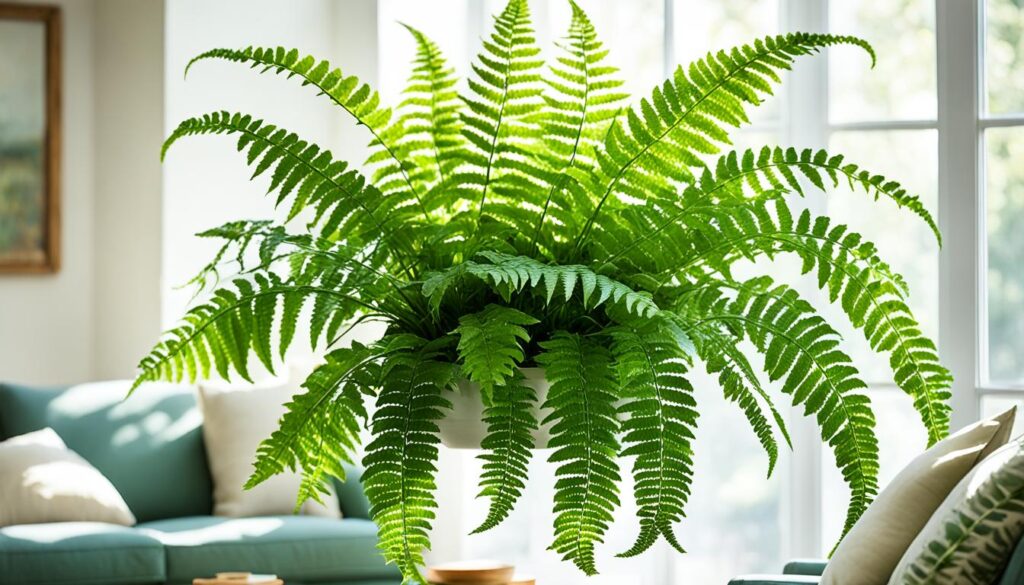
Boston ferns aren’t just good for the air; they also beautify your space. Their leafy fronds can bring a peaceful vibe to any room. You can hang them or put them on a stand. Either way, they’ll make your room look more lively and green.
Tips for Caring for a Boston Fern:
- Place the fern in bright, indirect sunlight
- Maintain high humidity levels by misting or using a humidifier
- Water the fern thoroughly, allowing the water to drain before watering again
- Avoid overwatering to prevent root rot
- Monitor the fern for signs of pests, such as spider mites or mealybugs
The Boston fern is a top pick for cleaner air and lovely decor. It’s a great way to freshen up your space. Plus, it’s pretty easy to care for.
Mother-in-Law’s Tongue (Snake Plant): Beginner-Friendly and Air-Purifying
Mother-in-Law’s Tongue, known as the snake plant, is great for beginners. It comes from tropical areas and is used to tough conditions. It can deal with neglect and doesn’t need much light.
The snake plant looks good and cleans the air. It gets rid of harmful toxins like trichloroethylene and xylene. This makes it a top choice for healthy indoor air.
Snake plants don’t need much care. You only need to water them every two weeks. They’re ideal for people who are busy or might forget to water plants. Their thick leaves store water, which helps.
Snake plants like indirect light but are okay in the dark. This means you can put them in many places, even rooms with little light.
The snake plant is easy for beginners. It makes your space greener and the air cleaner.
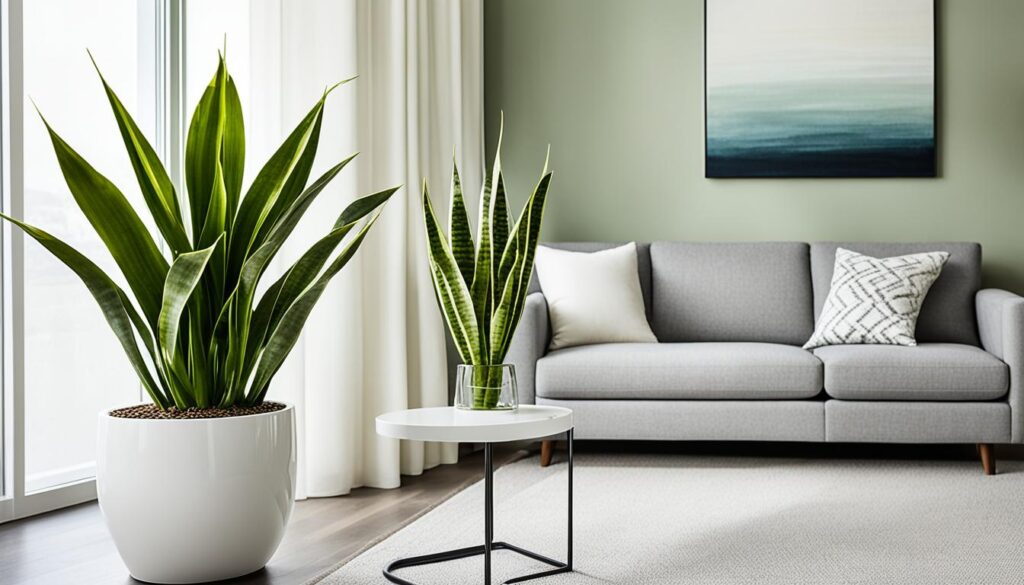
Snake Plant Care Tips:
- Place the snake plant in indirect sunlight, but it can tolerate low light conditions.
- Water the snake plant once every two weeks, allowing the soil to dry out between waterings.
- Avoid overwatering, as snake plants are susceptible to root rot.
- Use well-draining soil and a pot with drainage holes to prevent waterlogged roots.
- Snake plants are drought-tolerant and can withstand periods of neglect, making them perfect for busy individuals.
ZZ-Plant: Thrives in Low Light Areas and Removes Harmful Chemicals
ZZ-plants are a fantastic choice for improving indoor air quality, especially in areas with little light. They look great with their wide, dark green leaves. Plus, they can take out harmful chemicals from the air. These plants come from areas in Africa where it’s very dry. So, they’re very tough and can handle difficult conditions. They get rid of bad things like benzene, toluene, and xylene. These are common pollutants in indoor air.
ZZ-plants are great because they can handle different kinds of light. They work well in many parts of your home, like offices, living rooms, or bedrooms. They’re also easy to take care of when it comes to watering. This is good for people who are busy or might not be great at taking care of plants. You should water them only after the soil has completely dried out. This is because their roots can rot if they get too much water.
For the best growth and health, you should give your ZZ-plant a balanced liquid fertilizer every month. This helps the plant get all the nutrients it needs. If you take good care of them, ZZ-plants can grow up to two to three feet tall. This adds a lovely touch of green to your space.

Getting a ZZ-plant does more than just make your home look better. It also makes your living space cleaner and healthier. The ZZ-plant is a top pick for anyone wanting to make the air indoors better. It does a great job in places without much light.
Peace Lily: Low Light Tolerance and Effective Air Purification
Peace lilies are beautiful and help make the air cleaner. They do well in less light, perfect for dark rooms. These plants remove harmful substances like ammonia and benzene, making the air fresh.
These plants are great for those new to gardening. They don’t need a lot of work and like to be watered weekly. They should get some light, even indirect, to grow well and bloom.
“Peace lilies are not only visually appealing but also great for improving indoor air quality. They can eliminate pollutants such as ammonia, trichloroethylene, benzene, formaldehyde, and xylene.”
Peace lilies also bring a calm, elegant look to any space. With their dark green leaves and white flowers, they add a peaceful vibe. They are often chosen to make indoor areas look better.
A peace lily is a good choice if you want a plant that purifies the air and looks elegant.
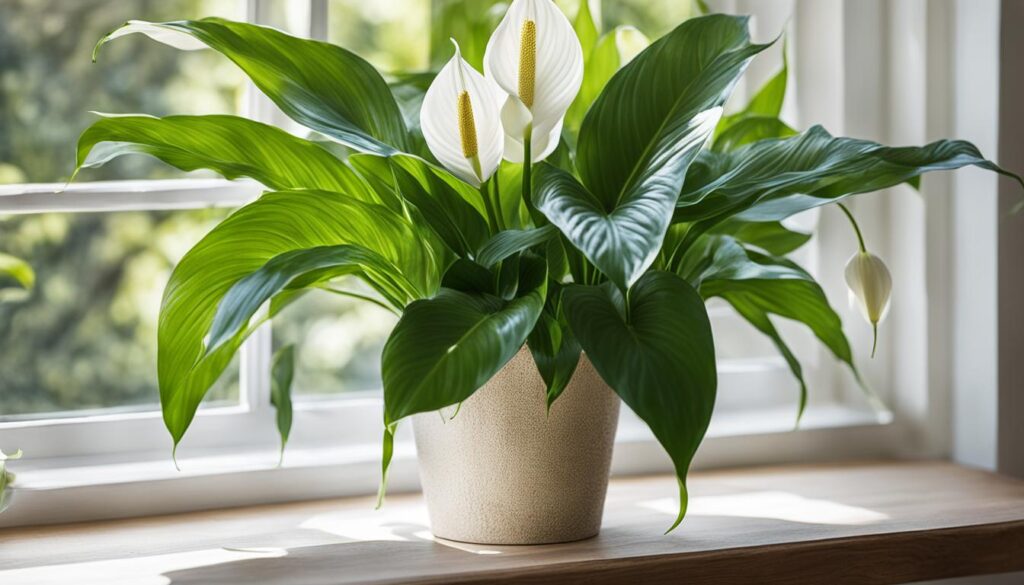
Peace Lily Care Tips:
- Place in low light conditions, away from direct sunlight.
- Water once a week, allowing the soil to dry out slightly between waterings.
- Maintain humidity by misting the leaves with water regularly.
- Trim brown or yellow leaves to keep the plant looking its best.
Comparison of Air-Purifying Abilities of Select Houseplants
| Plant | Purified Pollutants | Light Requirements | Watering Needs |
|---|---|---|---|
| Peace Lily | Ammonia, trichloroethylene, benzene, formaldehyde, xylene | Low light | Water once a week |
| Spider Plant | Xylene, formaldehyde | Moderate to bright indirect light | Water two to three times a week |
| Boston Fern | Cigarette smoke, formaldehyde, toluene, xylene, benzene | Indirect sunlight | Water when the top inch of soil is dry |
| Mother-in-Law’s Tongue (Snake Plant) | Trichloroethylene, xylene, formaldehyde, toluene, benzene | Low to bright indirect light | Water every two weeks |
English Ivy: Versatile and Air-Purifying, but Toxic to Pets
English Ivy stands out among houseplants for its versatility and air-purifying abilities. It fits well in various indoor settings, becoming a favorite for many. This plant is known for eliminating air toxins like carbon monoxide and benzene.
By adding English Ivy to your space, you beautify and purify your home. Its long vines are perfect for hanging baskets or draping over windowsills. This adds a lovely, natural touch to any area.

However, it’s important to remember that English Ivy can be dangerous. The plant’s leaves and berries contain harmful substances if eaten. So, it’s key to be careful and keep the plant away from pets and kids.
Chinese Evergreen: Effective Air Purification and Varied Varieties
Chinese evergreens are top picks to improve indoor air. They pull nasty pollutants like benzene and formaldehyde from the air. This makes the air healthier for you and your family.
There are many stunning varieties of Chinese evergreens. The silver queen is famous for its beautiful silver-green leaves. You can find a Chinese evergreen that fits your home’s style, whether you like green or variegated leaves.
Chinese evergreens thrive even in low light, which is great. They are perfect for spots without direct sunlight. But remember, those with variegated leaves like a bit more light.
Taking good care of your Chinese evergreen is key. Don’t water it too much. Let the top inch of soil dry out first. Too much water can harm it.
These plants enjoy some humidity as well. During dry months, keep them happy with a water tray nearby or a light mist. This helps them grow well.
Choosing a Chinese evergreen is a smart move for clean air and beauty. Whether it’s a silver queen or another type, it will boost your home’s air and look great.
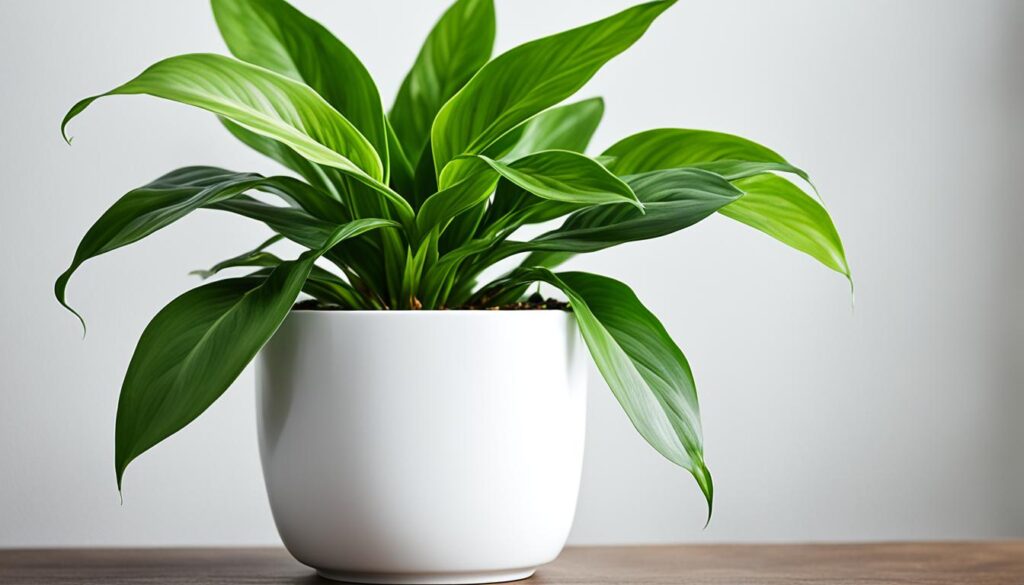
| Variety | Light Conditions | Watering Frequency |
|---|---|---|
| Silver Queen | Low to moderate light | Allow top inch of soil to dry between waterings |
| Emerald Bay | Low to moderate light | Allow top inch of soil to dry between waterings |
| Camouflage | Low to moderate light | Allow top inch of soil to dry between waterings |
Chrysanthemums: Beautiful Flowers and Effective Purification
Chrysanthemums, or mums, are beautiful and clean the air. They brighten up any area and help make the air healthier. These flowers are good at getting rid of harmful things like ammonia and formaldehyde. This makes them great for cleaner air at home.
They come in many colors and sizes. This means you can pick the perfect mums to match your style. Whether you want bright or soft colors, you will find a chrysanthemum that fits.
Chrysanthemums are also easy to look after. This makes them a top choice for both new and expert gardeners. Just water them, give them sunlight, and trim them occasionally. Doing this will help your flowers grow and keep your home beautiful.
Benefits of Chrysanthemums:
- Efficiently removes pollutants like ammonia, xylene, formaldehyde, and benzene
- Offers a wide range of colors and sizes to suit any decor
- Easy to care for, making them suitable for beginners
- Adds natural beauty and vibrancy to any indoor space
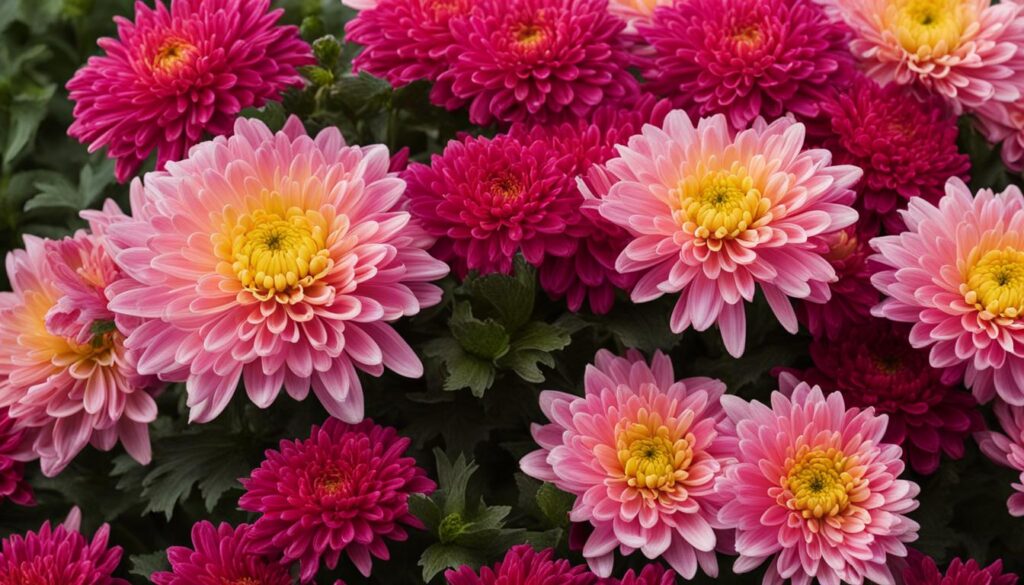
Add chrysanthemums to your home and see the difference. They not only make your space brighter but also improve the air. Enjoy living in a place that’s both beautiful and has clean, fresh air, thanks to these flowers.
Bamboo Palm: Tropical Flair and Air Purification
Looking for a tropical touch in your home? The Bamboo Palm is a great pick. It brings a tropical feeling with its lush, green fronds.
This plant doesn’t just look good, it cleans the air. It removes harmful pollutants. These include benzene and formaldehyde, making your home healthier.
Bamboo Palms need light and air to grow well. You should mist the leaves to keep them happy. Avoid overwatering to prevent root problems.
Adding a Bamboo Palm to your home means more than just beauty. You’ll get cleaner air too. It’s a top choice for a clean, tropical vibe indoors.